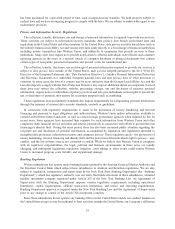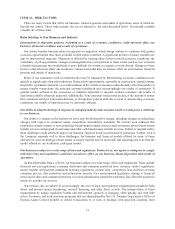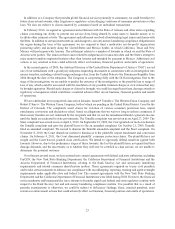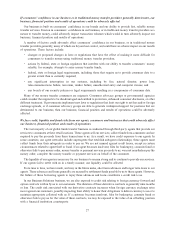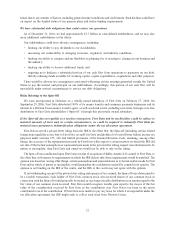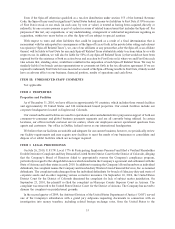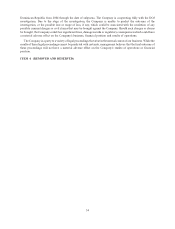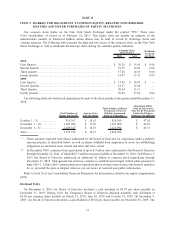Western Union 2010 Annual Report Download - page 28
Download and view the complete annual report
Please find page 28 of the 2010 Western Union annual report below. You can navigate through the pages in the report by either clicking on the pages listed below, or by using the keyword search tool below to find specific information within the annual report.Acquisitions and integration of new businesses create risks and may affect operating results.
We have acquired and may acquire businesses both inside and outside the United States. The acquisition and
integration of businesses involve a number of risks. The core risks involve valuation (negotiating a fair price for the
business based on inherently limited due diligence) and integration (managing the complex process of integrating
the acquired company’s people, products and services, technology and other assets in an effort to realize the
projected value of the acquired company and the projected synergies of the acquisition). In addition, the need in
some cases to improve regulatory compliance standards is another risk associated with acquiring companies.
Acquisitions often involve additional or increased risks including, for example:
• managing geographically separated organizations, systems and facilities;
• managing multi-jurisdictional operating, tax and financing structures;
• integrating personnel with diverse business backgrounds and organizational cultures;
• integrating the acquired technologies into our Company;
• realization of anticipated financial benefits from these acquisitions and where necessary, improving internal
controls of these acquired businesses;
• complying with regulatory requirements;
• fluctuations in currency exchange rates;
• enforcement of intellectual property rights in some foreign countries;
• difficulty entering new markets with the services of the acquired business; and
• general economic and political conditions, including legal and other barriers to cross-border investment in
general, or by United States companies in particular.
Integrating operations could cause an interruption of, or divert resources from, one or more of our businesses and
could result in the loss of key personnel. The diversion of management’s attention and any delays or difficulties
encountered in connection with an acquisition and the integration of the acquired company’s operations could have
an adverse effect on our business, financial position and results of operations.
As of December 31, 2010, we had $2,151.7 million of goodwill comprising approximately 27% of our total
assets. An impairment review of goodwill is conducted at least once a year and more frequently if events or changes
in circumstances indicate that the carrying value of the goodwill may not be recoverable. If we are unsuccessful in
integrating the businesses we have acquired or acquire in the future, or if these acquired businesses experience
declines in operating income or cash flows, adverse changes in the business climate, or if we are unable to
successfully execute our strategy for these businesses, we may be required to write down the goodwill on our
balance sheet associated with these acquisitions, which could have an impact on our financial position and results of
operations in future periods.
Our consolidated balance sheet may not contain sufficient amounts or types of regulatory capital to meet the
changing requirements of our various regulators worldwide, which could adversely affect our business, financial
position and results of operations.
We have substantial indebtedness as of December 31, 2010. Our regulators expect us to possess sufficient
financial soundness and strength to adequately support our regulated subsidiaries. In addition, although we are not a
bank holding company for purposes of United States law or the law of any other jurisdiction, as a global provider of
payments services and in light of the changing regulatory environment in various jurisdictions, we could become
subject to new capital requirements introduced or imposed by our regulators that could require us to issue securities
that would qualify as Tier 1 regulatory capital under the Basel Committee accords or retain earnings over a period of
time. Any of these requirements could adversely affect our business, financial position and results of operations.
26


